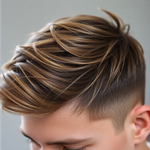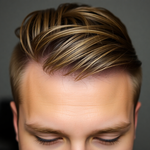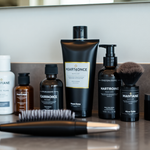
Wardrobe Color Theory: How Semi‑Permanent Hair Color Optimizes a Sustainable Men's Capsule
28 August 2025
Share
Hook: Look sharp, waste less — fast
Struggling to look intentional without buying more? Wardrobe Color Theory: How Semi‑Permanent Hair Color Optimizes a Sustainable Men's Capsule is about making one low-commitment grooming choice—your hair—do the heavy lifting for every outfit. In the first 100 words: this guide shows how to pick hair tones that multiply your capsule’s outfit count, cut decision fatigue, and reduce waste while keeping costs and chemical exposure low.
Why hair color matters to a capsule wardrobe
Most capsules focus on clothing, but hair is part of the visual equation. Your hair creates contrast, sets warmth or coolness, and can either clash with or enhance a curated palette. Semi‑permanent hair color gives you a reversible tool to align your personal palette with your clothes, so fewer garments achieve more distinct, deliberate looks.
Color theory basics for men (quick primer)
- Hue: The basic color family—blue, red, green.
- Value: Lightness or darkness. Dark hair increases contrast with light clothing; lighter hair softens contrast.
- Saturation: How vivid a color is. Muted tones (desaturated) pair well with earthy wardrobes; saturated accents work with high-contrast looks.
- Contrast harmony: High-contrast pairings (dark hair, light shirt) look sharp and modern. Low-contrast pairings (medium hair, mid-tone clothing) feel relaxed and cohesive.
Find your undertone and match like a pro
Skin undertone is the first thing to check. It determines which hair hues will feel natural and which will read jarring.
- Warm undertones: Gold/olive veins, golden jewelry looks better. Warm hair tones—golden brown, chestnut, copper—amplify your natural warmth.
- Cool undertones: Blue/purple veins, silver jewelry looks better. Cool ash browns, espresso, or dark cool blondes will harmonize.
- Neutral undertones: You can experiment; pick hair tones based on your capsule (warm capsule = warm hair).
Step-by-step: Aligning hair tone with your capsule
- Audit your capsule. Lay out 20–30 pieces and label them: neutrals (navy, black, grey), warm accents (rust, camel), cool accents (teal, burgundy). Count how many items land in each family.
- Decide your mood. Want high-contrast formal, low-contrast casual, or a hybrid? This will determine whether you darken, lighten, or neutralize your hair.
-
Pick a hair strategy:
- High-contrast capsule (black, white, jewel tones): go darker or keep a bold natural dark shade.
- Warm earthy capsule (olive, tan, rust): opt for warm chestnut, honey, or copper accents.
- Soft minimalist capsule (navy, grey, stone): choose cool ash brown or subtle highlights.
- Test a subtle change first. Use a semi‑permanent shade one level from your base or a temporary color powder to preview how outfits read in daylight.
- Commit for 4–8 weeks. Semi‑permanent dyes fade gradually—long enough to evaluate and adjust without long-term commitment.
Shade cheatsheet by base hair color
- Dark hair (black to deep brown): Add depth with cool espresso or lowlights; introduce warmth with subtle copper undertones if your capsule needs warmth.
- Medium brown: Most flexible—ash coolers for crisp urban looks, chestnut for earthy fats, or honey for a brighter seasonal shift.
- Light brown to blonde: Use toners or soft glazes to remove brassiness (cool ash) or add warmth (golden/honey) depending on capsule colors.
- Gray or salt-and-pepper: Embrace it and coordinate with accent colors—charcoal, navy, and forest green look premium with natural grey.
Why semi‑permanent hair color is the capsule-friendly choice
- Low commitment: Fades in weeks, so you can experiment seasonally or for events without long-term change.
- Less damaging: No ammonia and no permanent peroxide lift in many formulas, so hair integrity remains higher.
- Lower environmental impact: Fewer touch-ups and no frequent bleaching can reduce chemical runoff; choose brands with eco credentials for better results.
DIY vs salon: what to choose and when
Both have merit. Here’s a practical decision map.
- DIY at home: Good for small tone shifts (one level darker, toning brassiness). Pros: cheaper, immediate. Cons: risks uneven application for big changes.
- Salon: Best for multi-tonal looks, lifted blondes, or precision lowlights. Pros: professional color matching, longer-lasting blending. Cons: higher cost and potentially more chemical processing if lift is required.
Choosing eco-aware products (what to look for)
- Ammonia-free formulas and dyes that list minimal harsh solvents.
- Sulfate-free, color-safe shampoos and conditioners to preserve pigment and hair health.
- Brands that publish sustainability data or third-party certifications.
- Avoid excessive single-use plastic; favor refill options or brands with recyclable packaging.
For safety details and regulation context, consult the FDA’s guidance on hair dyes: FDA - Hair Dyes.
Practical maintenance schedule
- Week 0: Apply semi‑permanent tone according to instructions or get it done at a salon. Take reference photos in daylight.
- Weeks 1–2: Use cold or lukewarm water, sulfate-free shampoo; limit heat styling to preserve color.
- Weeks 3–6: Refresh with a glaze or color-depositing conditioner if you want consistent tone.
- Week 6–8: Evaluate—if you want a stronger or different result, refresh or switch strategies.
Outfit formulas that scale with hair tone
Apply these templates to any capsule to maximize combinations.
- The City Minimalist: Dark hair + navy blazer + white tee + grey trousers = high contrast, clean lines.
- The Outdoorsy Casual: Warm chestnut hair + olive field jacket + camel sweater + dark denim = cohesive earthy tone-on-tone look.
- The Creative Professional: Ash brown with subtle highlights + charcoal overcoat + burgundy knit + black chinos = modern, approachable polish.
- The Weekend Neutral: Light warm hair + beige bomber + white henley + olive joggers = soft, low-contrast comfort.
Cost and environmental math: why this reduces waste
Swapping a single hair decision for a new set of clothes is often cheaper and lower impact. Example: a semi‑permanent dye session or at-home kit can cost $20–$120 with one-time packaging; buying 3–5 new garments to chase a look often costs several hundred dollars and increases textile waste. A hair tone that harmonizes with multiple garments reduces impulse buys, extends outfit life, and lowers laundering frequency because looks feel deliberate.
Segmented examples: Which approach fits your lifestyle?
- Young professionals (22–30): Prioritize easy-to-maintain darker tones for interview-ready contrast. Pair with navy, charcoal, and crisp white shirts. Consider semi‑permanent as a test before any permanent decision for a job season.
- Creative types (24–35): Use semi‑permanent color both for hair experimentation and to accent statement pieces. Try subtle teal or cool ash tones if your capsule includes jewel accents.
- Outdoor and active (18–40): Warm, natural shades complement earth-toned technical outerwear. Choose eco-conscious formulas and quick 10-minute refresh routines.
- Budget-conscious shoppers: Semi‑permanent color is perfect because it’s inexpensive and reversible—helpful when you want a new look without a wardrobe overhaul.
Real-world case study: three-month transformation
Marcus, 34, kept a 28-piece capsule heavy on olive, tan, and navy. He felt his dark neutral hair flattened warm pieces. He chose a semi‑permanent chestnut glaze, refreshed at four weeks with a color-depositing conditioner. Outcome: his existing jackets and knitwear suddenly looked richer; he canceled plans for two purchases, wore existing clothes more often, and reported fewer outfit decisions each morning. He spent under $70 for three months of improved cohesion.
Photo and visuals: how to present this content online
- Create before/after hero shots showing the same outfit with two hair tones (alt text: 'Same outfit with cool ash hair vs warm chestnut hair').
- Use close-ups for hair texture and color sheen; caption each with the hair tone and the capsule palette.
- Consider an infographic mapping hair tones to capsule palettes and weekly maintenance steps.
Common FAQs
- Does semi‑permanent color damage hair?
- Generally less than permanent color because it doesn’t lift the hair cuticle as aggressively. Still, follow aftercare: sulfate-free products and limited heat.
- How long will it last?
- Typically 4–8 weeks depending on wash frequency, water temperature, and product type.
- Can I return to my natural color?
- Yes—since it fades, you’ll slide back toward your original tone without a heavy correction process.
Menll.com note (subtle product placement)
If you’re building a capsule that reads premium and sustainable, start with reliable core pieces—Menll.com’s core wardrobe collection has eco-oriented tees, durable outerwear, and neutral staples that pair well with refined hair tones. Explore the collection here: Menll.com core wardrobe. A small shift in hair tone plus these staples equals major style returns without extra shopping.
Checklist: implement this in a weekend
- Day 1 morning: Audit your capsule and take reference photos of your key outfits.
- Day 1 afternoon: Identify skin undertone and pick two semi‑permanent shades to test.
- Day 2 morning: Try a temporary color powder or visit a salon for a small glaze.
- Days 3–14: Wear your favorite outfits and photograph them in daylight to evaluate harmony.
- Week 3: Decide to commit for a 4–8 week cycle or adjust tone and repeat testing.
Final thoughts
Wardrobe color theory and semi‑permanent hair color together offer a practical, sustainable lever for men who want more style with less shopping. You get reversible experimentation, reduced waste, and a clearer visual identity for your capsule. Start small, test in daylight, and let a single, intentional hair tone amplify every piece you already own.
Call to action
Which hair-tone pairing will you test first with your capsule? Share your plan in the comments below—or browse Menll.com’s core wardrobe to pick pieces that’ll work with your new tone.
Vorheriger Beitrag

Color Anchors: Build a Low‑Waste Men's Capsule Wardrobe Around Semi‑Permanent Hair Color
Aktualisiert am 29 August 2025
Nächster Beitrag

From Roots to Rotation: Pair Semi-Permanent Hair Color with a Sustainable Men's Capsule Wardrobe
Aktualisiert am 27 August 2025





